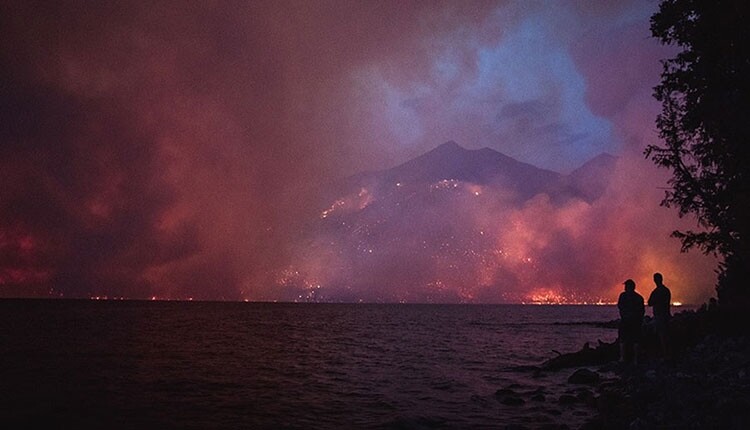
The cover of the Fourth National Climate Assessment uses a photo of the August 2018 Howe Ridge Fire in Glacier National Park in Montana.
(Image credit - National Park Service)

The cover of the Fourth National Climate Assessment uses a photo of the August 2018 Howe Ridge Fire in Glacier National Park in Montana.
(Image credit - National Park Service)
On Nov. 23, the Trump administration released volume two of the Fourth National Climate Assessment
Like the third NCA, released in 2014, the new report is largely built around two scenarios for future greenhouse gas emissions that establish a broad range of potential climate change impacts. The report also presents more localized analysis than its predecessors in an effort to improve guidance to decision-makers in preparing for and mitigating climate change.
The Trump administration has sought to distance itself from the report. In particular, administration officials have criticized the report’s use of a high-emissions scenario, asserting it is overly pessimistic.
The NCA is produced through the interagency U.S. Global Change Research Program (USGCRP). Volume two was assembled over a two-year period by 300 authors drawn from federal agencies, industry, universities, and other research institutions. In addition to undergoing a series of internal reviews, it was opened for public comment and externally reviewed by an expert committee convened by the National Academies.
The NCA identifies several ways it departs from its predecessor. In particular, it observes that the authors worked to make the NCA — encompassing both the report and associated “tools” — more useful to stakeholders, noting,
Hundreds of states, counties, cities, businesses, universities, and other entities are implementing actions that build resilience to climate-related impacts and risks, while also aiming to reduce greenhouse gas emissions.
The report states this iteration of the NCA also includes “broader and more systematic quantification of climate change impacts in economic terms” than the prior assessment. It acknowledges, though, that assessing economic impacts is still an “emerging body of literature” that does not yet cover all geographic regions.
Identifying scientific advances since the last NCA, the report points to an increasing ability to identify impacts at more localized scales. It states that knowledge is improving around atmospheric circulation, ice loss, and the impacts of warming and acidification on oceans and coastal waters. And it observes there is improved understanding of how climate change affects extreme events such as floods, droughts, and wildfires, though it notes “the current state of the science does not yet permit detailed understanding.”
Among the NCA’s overarching conclusions are that the impacts of climate change are “intensifying” across the U.S. and that the evidence of human contributions to climate change is “overwhelming and continues to strengthen.” The report also stresses there remains a potential for future “surprises” that scientists have not identified but could have major consequences.
“The more the climate changes, the greater the potential for these surprises,” it notes.

This figure from the Fourth National Climate Assessment illustrates the impacts of climate change on environmental conditions.
(Image credit - USGCRP)
The Trump administration’s decision to release the NCA ahead of schedule and on the day after the Thanksgiving holiday raised widespread suspicions
Then, following its release, the administration began to criticize the report. A White House spokesperson asserted
These criticisms elicited a rebuttal from Katharine Hayhoe, the lead author of a chapter
When first asked about the report, President Trump replied
Since the release
Acting Environmental Protection Agency Administrator Andrew Wheeler offered the administration’s most detailed criticisms of the NCA to date in an interview
I think a lot of the criticism that you’ve seen from the Trump administration on the report is the emphasis from the media on the worst-case scenario in the report, which is based on — I believe it’s called the RCP8.5, which is the worst-case scenario. It’s a scenario that the U.N.’s IPCC is moving away from.

This figure from the Fourth National Climate Assessment shows global carbon emissions and average temperature changes under three RCP scenarios. Click to enlarge.
(Image credit - USGCRP)
Asked about the more moderate scenario of RCP4.5 that the NCA also considered, Wheeler said that both RCP8.5 and 4.5 “downplay innovation and innovation that we’ve seen already in the marketplace.” He suggested specifically that the scenarios do not account for reductions in carbon dioxide emissions that have already been achieved.
Wheeler also suggested the Obama administration compelled the NCA to use RCP8.5 for its high-end scenario, saying, “I don’t know this for a fact, but I wouldn’t be surprised if the Obama administration told the report’s authors, ‘Take a look at the worst-case scenario for this report.’” He added that the next NCA might employ different assumptions, remarking, “I don’t think it’s appropriate to … project that there will be no further innovations in technology going forward.”
Later that day, EPA released
In justifying its use of the scenarios, the NCA states, “Current trends in annual greenhouse gas emissions, globally, are consistent with RCP8.5.” It observes that RCP4.5, which entails 85 percent lower greenhouse gas emissions than RCP8.5 by 2100, is “generally associated with lower population growth, more technological innovation, and lower carbon intensity in the global energy mix.”
The report notes it does not evaluate the “feasibility of the socioeconomic assumptions” underlying the scenarios. It explains the scenarios’ function is to “capture a range of potential greenhouse gas pathways and associated atmospheric concentration levels through 2100.”
It further states, “The resulting range of projections reflects, in part, the uncertainty that comes with quantifying future human activities and their influence on climate.”